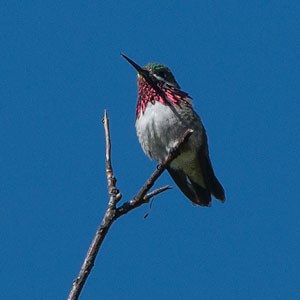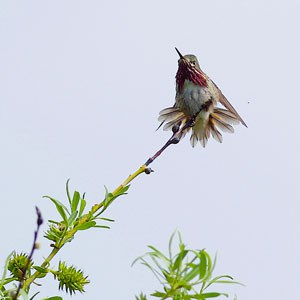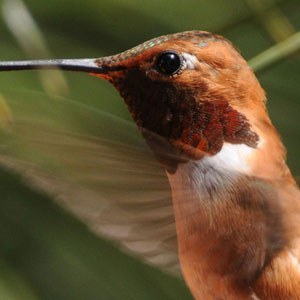Bzzzzzt! Something green goes torpedoing past you. Bzzzzt! Back it flies in the opposite direction. As summer arrives in Central Oregon, the sound of hummingbirds flying through the skies on their way to the next delicious flower is common. Learn more about hummingbirds and the handful that live in Central Oregon with this guide.
Some fun facts about hummingbirds:
- Hummingbirds can beat their wings up to 70 times per second.
- They are solitary birds and tend to be quite aggressive, with unmistakable "chase calls."
- They can fly backwards!
- Hummingbirds are only found in the Americas and the Caribbean Islands.
- Vision is a hummingbird's most important sense. They see all the colors we can see, but also see ultraviolet (UV) light, meaning their world is even more colorful than ours!
- Hummingbirds feed on flower nectar, small insects, and spiders.
- To survive cold nights (and save energy), hummingbirds can slow their heart rate by more than 90% and drop their body temperature more than 50%.
- Hummingbirds have tiny legs and cannot hop or walk.
Here are a few of the hummingbirds that have been spotted at Camp Polk Meadow Preserve:
Anna's hummingbirds are found along the Pacific Coast of North America, not going inland much further than Central Oregon. They are year-round residents in our region. Anna's hummingbirds are about 4" long and weigh around 4.3 grams. For a hummingbird, they have a relatively short bill (notice this in the photo to the left). Birds have iridescent green feathers; males have a red throat and crown, while females have a red central patch on their throat.
In courtship displays, the male Anna's hummingbird will fly up to 130 feet in the air, then swoop down vertically, making an unusual sound that's produced through their tail feathers. This display lasts about 12 seconds. On sunny days, these dives are oriented so that the sun reflects off their iridescent throat and crown directly at the female Anna's hummingbird they are trying to impress.
This is the smallest hummingbird in the United States! Calliope hummingbirds are around 3.25" long and weigh only 2.7 grams (the weight of a ping pong ball!). Even though they are small, they are mighty and have been known to chase off red-tailed hawks! Calliope hummingbirds are named after Calliope, the muse of eloquence and epic poetry in Greek mythology. Males have a streaked magenta throat with a white stripe across their cheek. Females have a pale, buff-colored chest. They can be found throughout most of the western US at one point or another.
Calliope hummingbirds have an oval-shaped migration route. They travel more than 5,000 miles each year during their migration from the pine-oak forests of Mexico. In the spring, they move north along the Pacific Coast, then return to their wintering grounds via the Rocky Mountains. 
Unmistakable from other hummingbirds in Central Oregon, the Rufous hummingbird is so named due to the brilliant orange-red feathers that cover the bodies of males. Females have green back feathers with an orange-red central throat. These hummingbirds are 3.75" long and weigh around 3.4 grams. Rufous hummingbirds are recognized as quite feisty! If you have a hummingbird feeder, you've probably noticed they are your most aggressive hummingbird and are constantly chasing off others. Rufous hummingbirds breed farther north than any other hummingbird, reaching all the way to Alaska. They have a similar migration route to Calliope hummingbirds, flying north along the Pacific Coast and returning south via the Rocky Mountains.
The next time a hummingbird goes zooming past, I hope this guide gives you a better idea of what you're looking at and helps you appreciate the incredible wonder that is hummingbirds.
Sources: The Cornell Lab of Ornithology and The Sibley Field Guide to Birds of Western North America.
Learn more:
- How to Use Binoculars (the Right Way)
- Birds of Camp Polk Meadow Preserve
- Cool Words for Hot Times: Indicator Species


